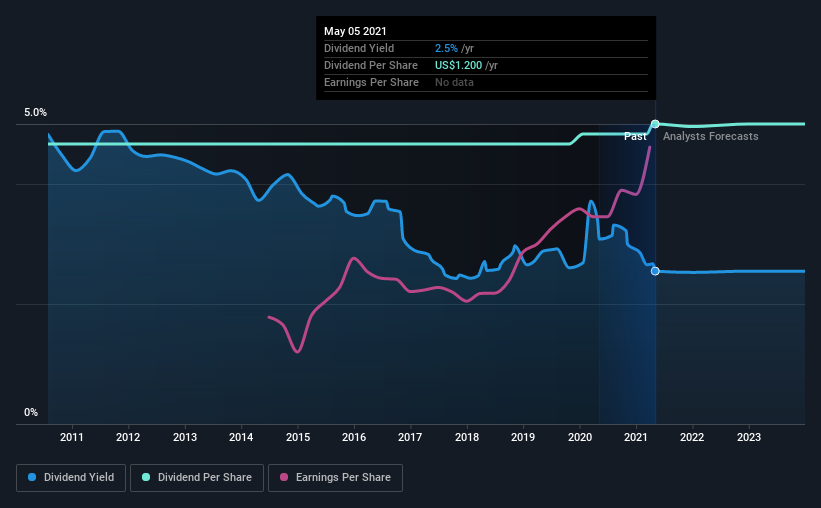- United States
- /
- Banks
- /
- NasdaqCM:SAL
Should Salisbury Bancorp, Inc. (NASDAQ:SAL) Be Part Of Your Dividend Portfolio?

Dividend paying stocks like Salisbury Bancorp, Inc. (NASDAQ:SAL) tend to be popular with investors, and for good reason - some research suggests a significant amount of all stock market returns come from reinvested dividends. If you are hoping to live on your dividends, it's important to be more stringent with your investments than the average punter. Regular readers know we like to apply the same approach to each dividend stock, and we hope you'll find our analysis useful.
A 2.5% yield is nothing to get excited about, but investors probably think the long payment history suggests Salisbury Bancorp has some staying power. Some simple research can reduce the risk of buying Salisbury Bancorp for its dividend - read on to learn more.
Explore this interactive chart for our latest analysis on Salisbury Bancorp!

Payout ratios
Dividends are typically paid from company earnings. If a company pays more in dividends than it earned, then the dividend might become unsustainable - hardly an ideal situation. As a result, we should always investigate whether a company can afford its dividend, measured as a percentage of a company's net income after tax. Looking at the data, we can see that 23% of Salisbury Bancorp's profits were paid out as dividends in the last 12 months. Given the low payout ratio, it is hard to envision the dividend coming under threat, barring a catastrophe.
Consider getting our latest analysis on Salisbury Bancorp's financial position here.
Dividend Volatility
One of the major risks of relying on dividend income, is the potential for a company to struggle financially and cut its dividend. Not only is your income cut, but the value of your investment declines as well - nasty. For the purpose of this article, we only scrutinise the last decade of Salisbury Bancorp's dividend payments. During this period the dividend has been stable, which could imply the business could have relatively consistent earnings power. During the past 10-year period, the first annual payment was US$1.1 in 2011, compared to US$1.2 last year. Its dividends have grown at less than 1% per annum over this time frame.
While the consistency in the dividend payments is impressive, we think the relatively slow rate of growth is unappealing.
Dividend Growth Potential
While dividend payments have been relatively reliable, it would also be nice if earnings per share (EPS) were growing, as this is essential to maintaining the dividend's purchasing power over the long term. Strong earnings per share (EPS) growth might encourage our interest in the company despite fluctuating dividends, which is why it's great to see Salisbury Bancorp has grown its earnings per share at 13% per annum over the past five years. Earnings per share are growing at a solid clip, and the payout ratio is low. We think this is an ideal combination in a dividend stock.
Conclusion
When we look at a dividend stock, we need to form a judgement on whether the dividend will grow, if the company is able to maintain it in a wide range of economic circumstances, and if the dividend payout is sustainable. Firstly, we like that Salisbury Bancorp has a low and conservative payout ratio. Next, growing earnings per share and steady dividend payments is a great combination. Salisbury Bancorp fits all of our criteria, and we think there are a lot of positives to it from a dividend perspective.
Companies possessing a stable dividend policy will likely enjoy greater investor interest than those suffering from a more inconsistent approach. At the same time, there are other factors our readers should be conscious of before pouring capital into a stock. You can also discover whether shareholders are aligned with insider interests by checking our visualisation of insider shareholdings and trades in Salisbury Bancorp stock.
If you are a dividend investor, you might also want to look at our curated list of dividend stocks yielding above 3%.
If you decide to trade Salisbury Bancorp, use the lowest-cost* platform that is rated #1 Overall by Barron’s, Interactive Brokers. Trade stocks, options, futures, forex, bonds and funds on 135 markets, all from a single integrated account. Promoted
New: Manage All Your Stock Portfolios in One Place
We've created the ultimate portfolio companion for stock investors, and it's free.
• Connect an unlimited number of Portfolios and see your total in one currency
• Be alerted to new Warning Signs or Risks via email or mobile
• Track the Fair Value of your stocks
This article by Simply Wall St is general in nature. It does not constitute a recommendation to buy or sell any stock, and does not take account of your objectives, or your financial situation. We aim to bring you long-term focused analysis driven by fundamental data. Note that our analysis may not factor in the latest price-sensitive company announcements or qualitative material. Simply Wall St has no position in any stocks mentioned.
*Interactive Brokers Rated Lowest Cost Broker by StockBrokers.com Annual Online Review 2020
Have feedback on this article? Concerned about the content? Get in touch with us directly. Alternatively, email editorial-team (at) simplywallst.com.
About NasdaqCM:SAL
Salisbury Bancorp
Salisbury Bancorp, Inc. operates as the bank holding company for Salisbury Bank and Trust Company that provides commercial banking, consumer financing, retail banking, and trust and wealth advisory services.
Flawless balance sheet average dividend payer.
Similar Companies
Market Insights
Community Narratives




